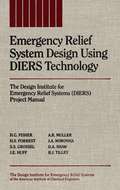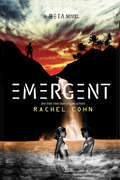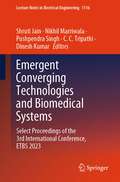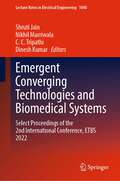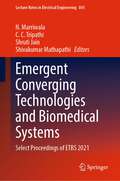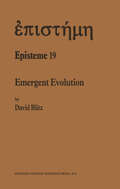- Table View
- List View
Emergency Relief System Design Using DIERS Technology: The Design Institute for Emergency Relief Systems (DIERS) Project Manual
by H. G. Fisher H. S. Forrest Stanley S. Grossel J. E. Huff A. R. Muller J. A. Noronha D. A. Shaw B. J. TilleyOSHA (29 CFR 1910.119) has recognized AIChE/DIERS two-phase flow publications as examples of "good engineering practice" for process safety management of highly hazardous materials. The prediction of when two-phase flow venting will occur, and the applicability of various sizing methods for two-phase vapor-liquid flashing flow, is of particular interest when designing emergency relief systems to handle runaway reactions. This comprehensive sourcebook brings together a wealth of information on methods that can be used to safely size emergency relief systems for two-phase vapor-liquid flow for flashing or frozen, viscous or nonviscous fluids. Design methodologies are illustrated by selected sample problems. Written by industrial experts in the safety field, this book will be invaluable to those charged with operating, designing, or managing today's and tomorrow's chemical process industry facilities.
Emergency Response Decision Support System (SpringerBriefs in Business)
by Siqing Shan Qi YanThis book mainly addresses the Emergency Response Decision Support System (ERDSS) and its applications, making use of ten related modules and a number of key technologies, especially Disaster Assessing Technology, Adaptive Information Evaluation Technology and Knowledge Management Technology. The book is especially valuable in coping with disasters that result in the loss of human life and property, and which threaten the stability of our societies. The ERDSS enables people to prepare for potential incidents, to rapidly respond to them, and to cope with their aftermath. Presenting practical solutions, this book helps readers to understand the ERDSS and effectively respond to emergency events.
Emergency Response Planning: For Corporate and Municipal Managers
by Paul A. EricksonEmergencies wreak havoc on businesses and governments on a daily basis. Whether it is a hurricane pounding a coastal community, a terrorist attack on a company's headquarters, or a hazardous chemical spill at a local school, the results can be loss of life, health, and property. How can you prevent or reduce the effects of such occurrences? By planning ahead.Emergency Response Planning is designed to help corporate and municipal managers quickly understand their roles in proactive and reactive emergency management. Author Paul Erickson shows how to develop partnerships with federal, state, and local government agencies, as well as community groups in order to prevent, prepare for, and respond to natural disasters and manmade emergencies.Emergency Response Planning provides essential information to help you comply with government regulations, design an emergency response plan, train personnel, use the proper safety equipment, safeguard information systems, and resume normal operations after an emergency as quickly as possible. It will also help consultants design emergency response plans for their clients, and provide practical information for students studying business continuity and emergency issues.Is an important resource for: - Corporate and municipal managers involved in emergency management - Organizational safety committee members - Industrial health and safety consultants and their clients - Graduate and undergraduate students studying emergency response issues - Outlines both proactive and reactive strategies to reduce risk to human life, health, and property - Describes how to form effective partnerships with government agencies and community support resources - Defines the roles of corporate and municipal managers, planning team members, and response personnel - Explains regulations and guidelines from key agencies including OSHA, EPA, FEMA, CDC, US Fire Administration, and more - Makes information easy to understand with dozens of tables, illustrations, and appendices
Emergency Surgical Management of Colorectal Cancer (Hot Topics in Acute Care Surgery and Trauma)
by Nicola De’Angelis Salomone Di Saverio Francesco BrunettiThis volume provides an overview of the current evidence-based medical and surgical practice in emergency conditions in colorectal cancer patients. It offers a multidisciplinary perspective, taking into account the specific characteristics of colorectal cancer patients, the necessary pre-operative assessment, the endoscopic and radiological management, and the surgical treatments. Each chapter is supplemented with tables, figures, key-point boxes, schematic representations, and decision-making trees that serve as easy-to-use tools to apply in the different scenarios requiring acute care. Recommendations for best practice and the main reference articles are included for each topic, as well as numerous illustrated clinical cases with cilnical and empirical evidence regarding the surgical management of colorectal cancer. Specific technical aspects of the different surgical interventions and approaches (e.g., open surgery, laparoscopy, and robotics) are also detailed. This book is intended for residents and emergency surgeons, as well as all practictioners who treat colorectal cancer patients, such as gastroenterologists, oncologists, and radiologists.
Emergent (A Beta Novel)
by Rachel CohnA clone revolution is brewing.Zhara, the First. Elysia, her clone. On the surface, they are identical. But looks can be deceiving. When Zhara plays, she plays to win. She thought she had escaped the horrors of Doctor Lusardi's cloning compound. But the nightmare is just beginning. Elysia has taken everything from Zhara--a softer, prettier version of herself and an inescapable reminder of all she's failed at in her life. Now the man Zhara loves has replaced her with Elysia. Zhara will get her clone out of the way, no matter the cost. Elysia has finally learned the truth: she has a soul. Her First is alive. She knows it hurts Zhara to see her with Alexander, but she can't give him up. The genetically-perfected Aquine has chosen as her as his life mate, and their days together are limited. Elysia can't remain in the Rave Caves off the shores of Denesme forever. Revolution is brewing on the island paradise. Hundreds of soulless clones remain imprisoned like Elysia once was, slaves to the whims of their owners--wealthy human inhabitants of the island. As a group of clones and humans, led by Alexander, plot an insurrection that will turn Denesme's world upside down, Elysia knows her place is fighting by his side. Terrible sacrifices must be made to defeat Denesme's twisted regime. But even the greatest losses cannot prepare Elysia for the ticking time bomb built into her own programming...
Emergent Complexity from Nonlinearity, in Physics, Engineering and the Life Sciences: Proceedings of the XXIII International Conference on Nonlinear Dynamics of Electronic Systems, Como, Italy, 7-11 September 2015 (Springer Proceedings in Physics #191)
by Giorgio Mantica Ruedi Stoop Sebastiano StramagliaThis book collects contributions to the XXIII international conference “Nonlinear dynamics of electronic systems”. Topics range from non-linearity in electronic circuits to synchronisation effects in complex networks to biological systems, neural dynamics and the complex organisation of the brain. Resting on a solid mathematical basis, these investigations address highly interdisciplinary problems in physics, engineering, biology and biochemistry.
Emergent Computation: Emphasizing Bioinformatics (Biological and Medical Physics, Biomedical Engineering)
by Matthew SimonEmergent Computation emphasizes the interrelationship of the different classes of languages studied in mathematical linguistics (regular, context-free, context-sensitive, and type 0) with aspects to the biochemistry of DNA, RNA, and proteins. In addition, aspects of sequential machines such as parity checking and semi-groups are extended to the study of the Biochemistry of DNA, RNA, and proteins. Mention is also made of the relationship of algebraic topology, knot theory, complex fields, quaternions, and universal turing machines and the biochemistry of DNA, RNA, and proteins. Emergent Computation tries to avoid an emphasis upon mathematical abstraction ("elegance") at the expense of ignoring scientific facts known to Biochemists. Emergent Computation is based entirely upon papers published by scientists in well-known and respected professional journals. These papers are based upon current research. A few examples of what is not ignored to gain "elegance": - DNA exists as triple and quadruple strands - Watson-Crick complementary bases have mismatches - There can be more than four bases in DNA - There are more than sixty-four codons - There may be more that twenty amino acids in proteins While Emergent Computation emphasizes bioinformatics applications, the last chapter studies mathematical linguistics applied to areas such as languages found in birds, insects, medical applications, anthropology, etc. Emergent Computation tries to avoid unnecessary mathematical abstraction while still being rigorous. The demands made upon the knowledge of chemistry or mathematics is minimized as well. The collected technical references are valuable in itself for additional reading.
Emergent Converging Technologies and Biomedical Systems: Select Proceedings Of The 2nd International Conference, Etbs 2022 (Lecture Notes In Electrical Engineering Ser. #1040)
by Shruti Jain Nikhil Marriwala Pushpendra Singh C. C. Tripathi Dinesh KumarEmergent Converging Technologies and Biomedical Systems: Select Proceedings of the 2nd International Conference, ETBS 2022 (Lecture Notes in Electrical Engineering #1040)
by Shruti Jain Nikhil Marriwala C. C. Tripathi Dinesh KumarThe book contains proceedings of the International Conference on Emergent Converging Technologies and Biomedical Systems ETBS 2022. It includes papers on wireless multimedia networks, green wireless networks, electric vehicles, biomedical signal processing and instrumentation, wearable sensors for health care monitoring, biomedical imaging, & bio-materials, modeling and simulation in medicine biomedical, and health informatics. The book will serve as a useful guide for educators, researchers, and developers working in the area of signal processing, imaging, computing, instrumentation, artificial intelligence, and their related applications. This book will also provide support and aid to the researchers involved in designing the latest advancements in healthcare technologies.
Emergent Converging Technologies and Biomedical Systems: Select Proceedings of ETBS 2021 (Lecture Notes in Electrical Engineering #841)
by N. Marriwala C. C. Tripathi Shruti Jain Shivakumar MathapathiThe book contains peer-reviewed proceedings of the International Conference on Emergent Converging Technologies and Biomedical Systems 2021. It includes papers on wireless multimedia networks, green wireless networks, electric vehicles, biomedical signal processing and instrumentation, wearable sensors for health care monitoring, biomedical imaging, & bio-materials, modeling and simulation in medicine biomedical and health informatics. The book will serve as a useful guide for educators, researchers, and developers working in the area of signal processing, imaging, computing, instrumentation, artificial intelligence, and their related applications. This book will also provide support and aid to the researchers involved in designing the latest advancements in healthcare technologies.
Emergent Evolution: Qualitative Novelty and the Levels of Reality (Episteme #19)
by David BlitzEmergent evolution combines three separate but related claims, whose background, origin, and development I trace in this work: firstly, that evolution is a universal process of change, one which is productive of qualitative novelties; secondly, that qualitative novelty is the emergence in a system of a property not possessed by any of its parts; and thirdly, that reality can be analyzed into levels, each consisting of systems characterized by significant emergent properties. In part one I consider the background to emergence in the 19th century discussion of the philosophy of evolution among its leading exponents in England - Charles Darwin, Herbert Spencer, T. H. Huxley, Alfred Russel Wallace, and G. J. Romanes. Unlike the scientific aspect of the debate which aimed to determine the factors and causal mechanism of biological evolution, this aspect of the debate centered on more general problems which form what I call the "philosophical framework for evolutionary theory." This considers the status of continuity and discontinuity in evolution, the role of qualitative and quantitative factors in change, the relation between the organic and the inorganic, the relation between the natural and the supernatural, the mind-body problem, and the scope of evolution, including its extension to ethics and morals.
Emergent Macroeconomics: An Agent-Based Approach to Business Fluctuations (New Economic Windows)
by Domenico Gatti Edoardo Gaffeo Mauro Gallegati Gianfranco Giulioni Antonio PalestriniThis valuable book contributes substantively to the current state-of-the-art of macroeconomics. It provides a method for building models in which business cycles and economic growth emerge from the interactions of a large number of heterogeneous agents. Drawing from recent advances in agent-based computational modeling, the authors show how insights from dispersed fields can be fruitfully combined to improve our understanding of macroeconomic dynamics.
Emergent Nested Systems: A Theory of Understanding and Influencing Complex Systems as well as Case Studies in Urban Systems (Understanding Complex Systems)
by Christian WallothThis book presents a theory as well as methods to understand and to purposively influence complex systems. It suggests a theory of complex systems as nested systems, i. e. systems that enclose other systems and that are simultaneously enclosed by even other systems. According to the theory presented, each enclosing system emerges through time from the generative activities of the systems they enclose. Systems are nested and often emerge unplanned, and every system of high dynamics is enclosed by a system of slower dynamics. An understanding of systems with faster dynamics, which are always guided by systems of slower dynamics, opens up not only new ways to understanding systems, but also to effectively influence them. The aim and subject of this book is to lay out these thoughts and explain their relevance to the purposive development of complex systems, which are exemplified in case studies from an urban system. The interested reader, who is not required to be familiar with system-theoretical concepts or with theories of emergence, will be guided through the development of a theory of emergent nested systems. The reader will also learn about new ways to influence the course of events - even though the course of events is, in principle, unpredictable, due to the ever-new emergence of real novelty.
Emergent Nonlinear Phenomena in Bose-Einstein Condensates: Theory and Experiment (Springer Series on Atomic, Optical, and Plasma Physics #45)
by Panayotis G. Kevrekidis Dimitri J. Frantzeskakis Ricardo Carretero-GonzálezThis book, written by experts in the fields of atomic physics and nonlinear science, covers the important developments in a special aspect of Bose-Einstein condensation, namely nonlinear phenomena in condensates. Topics covered include bright, dark, gap and multidimensional solitons; vortices; vortex lattices; optical lattices; multicomponent condensates; mathematical methods/rigorous results; and the beyond-the-mean-field approach.
Emergent Problems in Nonlinear Systems and Control (Lecture Notes in Control and Information Sciences #393)
by Bijoy Ghosh Clyde F. Martin Yishao ZhouPapers in this collection partly represent the set of talks that were presented at Texas Tech University on the occasion of Daya’s memorial workshop in the year 2007. Daya had a varied interest in the field of Dynamics and Control Theory and the papers bring out the essence of his involvement in these activities. He also had a large number of collaborators and this collection represent a good fraction of them. The papers included here cover his interest in control theory. Also included are papers from application areas that we believe are of strong interest to him.
Emergent Properties in Natural and Artificial Dynamical Systems (Understanding Complex Systems)
by Moulay Aziz-Alaoui Cyrille BertelleAn important part of the science of complexity is the study of emergent properties arising through dynamical processes, in various natural and artificial systems. This book presents multidisciplinary approaches for creating and modeling representations of complex systems, and a variety of methods for extracting emergent structures. Offering bio-complexity examples, the coverage extends to self organization, synchronization, stability and robustness. The contributors include researchers in physics, engineering, biology and chemistry.
Emergent Science: Teaching science from birth to 8
by Jane JohnstonEmergent Science is essential reading for anyone involved in supporting scientific learning and development with young children aged between birth and 8. Drawing on theory, the book helps to develop the essential skills needed to understand and support science in this age range. The book is organised into three parts: development, contexts and pedagogy, exploring the underpinning theory alongside practical ideas to help trainees, teachers and childcare practitioners to create high-quality science experiences for the children they teach. The text includes guidance on developing professional, study and research skills to graduate and postgraduate level, as well as all the information needed to develop scientific skills, attitudes, understanding and language through concrete, social experiences for young children. Features include: Reflective tasks-at three levels of professional development;- early career/student, developing career/teacher and later career/leader. Case studies that exemplify good practice and practical ideas. Tools for learning - explain how science professionals can develop their professional, study skills and research skills to Masters level
Emergent Science: Teaching science from birth to 8
by Jane JohnstonEmergent Science is essential reading for anyone involved in supporting scientific learning and development with young children aged between birth and 8. Drawing on theory, the book helps to develop the essential skills needed to understand and support science in this age range. The book is organised into three parts: development, contexts and pedagogy, exploring the underpinning theory alongside practical ideas to help trainees, teachers and childcare practitioners to create high-quality science experiences for the children they teach. The text includes guidance on developing professional, study and research skills to graduate and postgraduate level, as well as all the information needed to develop scientific skills, attitudes, understanding and language through concrete, social experiences for young children. Features include: Reflective tasks-at three levels of professional development;- early career/student, developing career/teacher and later career/leader. Case studies that exemplify good practice and practical ideas. Tools for learning - explain how science professionals can develop their professional, study skills and research skills to Masters level
The Emergent Self
by William HaskerIn The Emergent Self, William Hasker joins one of the most heated debates in analytic philosophy, that over the nature of mind. His provocative and clearly written book challenges physicalist views of human mental functioning and advances the concept of mind as an emergent individual.Hasker begins by mounting a compelling critique of the dominant paradigm in philosophy of mind, showing that contemporary forms of materialism are seriously deficient in confronting crucial aspects of experience. He further holds that popular attempts to explain the workings of mind in terms of mechanistic physics cannot succeed. He then criticizes the two versions of substance dualism most widely accepted today—Cartesian and Thomistic—and presents his own theory of emergent dualism. Unlike traditional substance dualisms, Hasker's theory recognizes the critical role of the brain and nervous system for mental processes. It also avoids the mechanistic reductionism characteristic of recent materialism.Hasker concludes by addressing the topic of survival following bodily death. After demonstrating the failure of materialist views to offer a plausible and coherent account of that possibility, he considers the implications of emergentism for notions of resurrection and the afterlife.
Emergent Spatio-temporal Dimensions of the City: Habitus and Urban Rhythms
by Fabian NeuhausThis book focuses on the creation of space as an activity. The argument draws not only on aspects of movement in time, but also on a cultural and specifically social context influencing the creation of the spatial habitus. The book reconsiders existing theories of time and space in the field of urban planning and develops an updated account of spatial activity, experience and space-making. Recent developments in spatial practice, specifically related to new technologies, make this an important and timely task. Integrating spatial-temporal dynamics into the way we think about cities aids the implementation of sustainable forms of urban planning. The study is composed of two different case studies. One case is based on fieldwork tracking individual movement using GPS, the other case utilises data mined from Twitter. One of the key elements in the conclusion to this book is the definition of temporality as a status rather than a transition. It is argued that through repetitive practices as habitus, time has presence and agency in our everyday lives. This book is based on the work undertaken for a PhD at the Centre for Advanced Spatial Analysis and was and accepted as thesis by University College London in 2013.
Emergent States in Photoinduced Charge-Density-Wave Transitions (Springer Theses)
by Alfred ZongThis book advances understanding of light-induced phase transitions and nonequilibrium orders that occur in a broken-symmetry system. Upon excitation with an intense laser pulse, materials can undergo a nonthermal transition through pathways different from those in equilibrium. The mechanism underlying these photoinduced phase transitions has long been researched, but many details in this ultrafast, non-adiabatic regime still remain to be clarified. The work in this book reveals new insights into this phenomena via investigation of photoinduced melting and recovery of charge density waves (CDWs). Using several time-resolved diffraction and spectroscopic techniques, the author shows that the light-induced melting of a CDW is characterized by dynamical slowing-down, while the restoration of the symmetry-breaking order features two distinct timescales: A fast recovery of the CDW amplitude is followed by a slower re-establishment of phase coherence, the latter of which is dictated by the presence of topological defects in the CDW. Furthermore, after the suppression of the original CDW by photoexcitation, a different, competing CDW transiently emerges, illustrating how a hidden order in equilibrium can be unleashed by a laser pulse. These insights into CDW systems may be carried over to other broken-symmetry states, such as superconductivity and magnetic ordering, bringing us one step closer towards manipulating phases of matter using a laser pulse.
Emergent Transport Properties of Magnetic Topological Insulator Heterostructures (Springer Theses)
by Kenji YasudaThis book reveals unique transport phenomena and functionalities in topological insulators coupled with magnetism and superconductivity. Topological insulators are a recently discovered class of materials that possess a spin-momentum-locked surface state. Their exotic spin texture makes them an exciting platform for investigating emergent phenomena, especially when coupled with magnetism or superconductivity. Focusing on the strong correlation between electricity and magnetism in magnetic topological insulators, the author presents original findings on current-direction-dependent nonreciprocal resistance, current-induced magnetization reversal and chiral edge conduction at the domain wall. In addition, he demonstrates how the coupling between superconductivity and topological surface state leads to substantial nonreciprocal resistance. The author also elucidates the origins of these phenomena and deepens readers’ understanding of the topologically nontrivial electronic state. The book includes several works which are published in top journals and were selected for the President’s Award by the University of Tokyo and for the Ikushi Prize, awarded to distinguished Ph.D. students in Japan.
Emergenzen auf der Stufe des Lebendigen (Schriften der Mathematisch-naturwissenschaftlichen Klasse #24)
by Hans Mohr Das Thema ‚Emergenzen in komplexen Systemen‘ wird derzeit viel diskutiert. Mit Emergenzen sind solche Strukturen und Eigenschaften eines Systems gemeint, die sich derzeit aus der Kenntnis der Teile des Systems und ihrer Wechselwirkungen nicht verstehen lassen. ‚Leben‘ zum Beispiel ist auch für den Molekularbiologen eine emergente Eigenschaft der Zelle, nicht aber ihrer Moleküle. ‚Bewusstsein‘ gilt nach wie vor als eine emergente Eigenschaft unseres Zentralnervensystems, nicht aber der einzelnen Neuronen. Emergenzen werden in Philosophie, Physik und Biologie unterschiedlich behandelt. Hans Mohr geht es vorrangig um eine zeitgerechte Würdigung der Bedeutung von Emergenzen bei der Erforschung komplexer Systeme in Biologie, Soziobiologie und Ökonomik.
Emerging and Eco-Friendly Approaches for Waste Management
by Ram Naresh Bharagava Pankaj ChowdharyRapid industrialization is a serious concern in the context of a healthy environment. With the growth in the number of industries, the waste generated is also growing exponentially. The various chemical processes operating in the manufacturing industry generate a large number of by-products, which are largely harmful and toxic pollutants and are generally discharged into the natural water bodies. Once the pollutants enter the environment, they are taken up by different life forms, and because of bio-magnification, they affect the entire food chain and have severe adverse effects on all life forms, including on human health. Although, various physico-chemical and biological approaches are available for the removal of toxic pollutants, unfortunately these are often ineffective and traditional clean up practices are inefficient. Biological approaches utilizing microorganisms (bacterial/fungi/algae), green plants or their enzymes to degrade or detoxify environmental pollutants such as endocrine disruptors, toxic metals, pesticides, dyes, petroleum hydrocarbons and phenolic compounds, offer eco- friendly approaches. Such eco-friendly approaches are often more effective than traditional practices, and are safe for both industry workers as well as environment. This book provides a comprehensive overview of various toxic environmental pollutants from a variety natural and anthropogenic sources, their toxicological effects on the environment, humans, animals and plants as well as their biodegradation and bioremediation using emerging and eco-friendly approaches (e.g. Anammox technology, advanced oxidation processes, membrane bioreactors, membrane processes, GMOs), microbial degradation (e.g. bacteria, fungi, algae), phytoremediation, biotechnology and nanobiotechnology. Offering fundamental and advanced information on environmental problems, challenges and bioremediation approaches used for the remediation of contaminated sites, it is a valuable resource for students, scientists and researchers engaged in microbiology, biotechnology and environmental sciences.
Emerging and Endemic Pathogens: Advances in Surveillance, Detection and Identification (NATO Science for Peace and Security Series A: Chemistry and Biology)
by Kevin P. O'Connell Evan W. Skowronski Lela Bakanidze Alexander SulakvelidzeIt is a truism among biologists that an organism’s phenotype is the product of both its genotype and its environment. An organism’s genotype contains the total informational potential of the individual, while its environment shapes the expression of the ge- type, influences the rate of mutation and occurrence of modifications, and ultimately determines the likelihood that the genotype (or fractions thereof) will survive into the next generation. In the relationship between host and pathogen, therefore, each forms a part of the environment of the other, mutually influencing the biology of both partners on scales ranging from the life history of individuals to the fate of populations or entire species. Molecular biologists working on problems in pathogenesis generally think of the host organism as the pathogen’s environment and perhaps occasionally consider the pathogen as part of the host’s environment. However, because “environment” can be defined at many scales, so, too, can phenotypes: if a pathogen, as a species, is c- sidered to exist in a host, as a species, then among its phenotypes is the nature of the pandemic disease it can cause within the host community. The contributors to the proceedings of this NATO Advanced Research Workshop have treated the interplay of environment and genotype in the host–pathogen relationship and its relationship to the problem of emerging infectious disease at both the macroscopic and microscopic/ molecular levels along this continuum of scale (with some human history thrown in at times for good measure).
